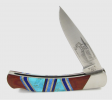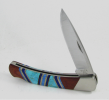- Joined
- Nov 5, 2012
- Messages
- 201
I just scored this like new 532. I’m not really fond of the "blade show" plain block lettering on the blade, and I think the knife would look better without it. I would like to remove it, but I’m concerned about getting it all off. It’s not laser etched into the blade, but appears to just be inked / stamped, etc.
Looking at the blade through a magnifier, I can see the tiny machining grooves that have the ink down in them. I’m concerned that I’ll get the letters mostly off, and that a faint shadow of them may still show through in the grooves, a situation I do not want. I suppose a buffing wheel would get them off, but I don’t have a wheel, and was thinking of trying to hand polish them away with something like Flitz or very fine wet sandpaper. As a last resort, I suppose Buck could remove them if I return it to the factory.
I was just wondering if anyone has successfully removed this style of lettering, and how you may have done it. Thanks in advance for any suggestions.

Looking at the blade through a magnifier, I can see the tiny machining grooves that have the ink down in them. I’m concerned that I’ll get the letters mostly off, and that a faint shadow of them may still show through in the grooves, a situation I do not want. I suppose a buffing wheel would get them off, but I don’t have a wheel, and was thinking of trying to hand polish them away with something like Flitz or very fine wet sandpaper. As a last resort, I suppose Buck could remove them if I return it to the factory.
I was just wondering if anyone has successfully removed this style of lettering, and how you may have done it. Thanks in advance for any suggestions.



